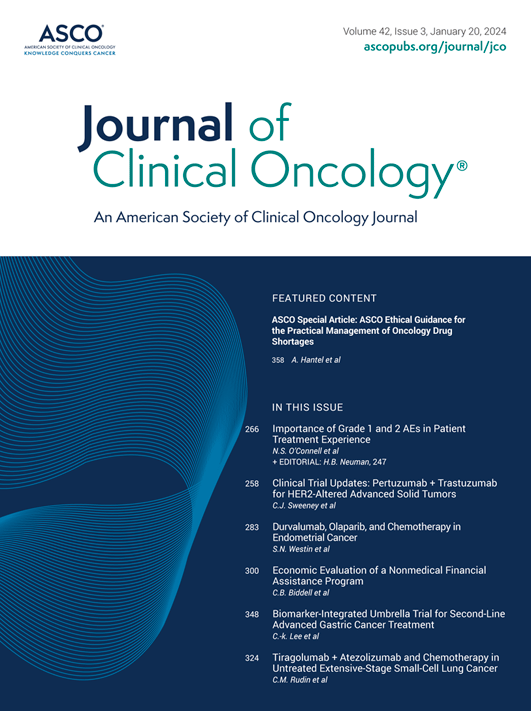Surgery Versus Ablation for Hepatocellular Carcinoma: A Randomized Controlled Trial (SURF-RCT Trial) and a Nonrandomized Prospective Observational Trial (SURF-Cohort Trial).
IF 42.1
1区 医学
Q1 ONCOLOGY
引用次数: 0
Abstract
PURPOSE We conducted a randomized controlled trial (SURF-RCT) to evaluate the efficacy of surgery versus radiofrequency ablation (RFA) for hepatocellular carcinoma (HCC). Simultaneously, eligible patients who dissented from random assignment were enrolled in a nonrandomized prospective observational trial (SURF-Cohort). We aimed to report the final analyses of overall survival (OS) and updated recurrence-free survival (RFS) in the SURF-RCT and SURF-Cohort trials. METHODS The trials were conducted in 49 institutions in Japan. Patients with a largest HCC diameter of ≤3 cm and ≤3 HCC nodules were eligible. The co-primary end points were RFS and OS. RESULTS During 2009-2015, 1,094 patients were registered. After excluding ineligible patients, 302 and 753 patients were included in the SURF-RCT (surgery, n = 150; RFA, n = 152) and SURF-Cohort trial (surgery, n = 382; RFA, n = 371), respectively. In the SURF-RCT trial, 90% of patients had solitary HCC, and approximately 65% had an HCC diameter of ≤2.0 cm. Serious adverse effects occurred in 3.3% of the surgery group and none in the RFA group. The 5-year OS was 74.6% in the surgery group and 70.4% in the RFA group (hazard ratio [HR], 0.96; adjusted P = .84). The 5-year RFS was 42.9% in the surgery group and 42.7% in the RFA group (HR, 0.90; adjusted P = .84). In the surgery group, 86 patients had recurrences; 14 (16.3%) underwent surgery, and 50 (58.1%) underwent RFA. In the RFA group, 95 patients had recurrences; 8 (8.4%) underwent surgery, and 55 (57.9%) underwent RFA. In the SURF-Cohort trial, baseline factors were imbalanced between groups. After adjusting with the inverse probability of treatment weighting analysis, OS and RFS showed no significant difference (P = .77 and P = .08). CONCLUSION The SURF trial did not demonstrate that surgery was superior to RFA for small HCC.肝细胞癌的手术与消融:一项随机对照试验(SURF-RCT试验)和一项非随机前瞻性观察试验(surf -队列试验)。
目的:我们进行了一项随机对照试验(SURF-RCT),以评估手术与射频消融(RFA)治疗肝细胞癌(HCC)的疗效。同时,不同意随机分配的符合条件的患者被纳入一项非随机前瞻性观察性试验(SURF-Cohort)。我们的目的是报告SURF-RCT和surf -队列试验中总生存期(OS)和最新无复发生存期(RFS)的最终分析。方法在日本49家机构进行临床试验。肝细胞癌最大直径≤3cm,肝细胞癌结节≤3个者入选。共同主要终点为RFS和OS。结果2009-2015年共登记患者1094例。在排除不符合条件的患者后,共有302例和753例患者被纳入SURF-RCT(手术,n = 150;RFA, n = 152)和surf队列试验(手术,n = 382;RFA, n = 371)。在SURF-RCT试验中,90%的患者为孤立性HCC,约65%的患者HCC直径≤2.0 cm。手术组发生严重不良反应的比例为3.3%,RFA组无严重不良反应。手术组5年OS为74.6%,RFA组为70.4%(风险比[HR], 0.96;调整后P = 0.84)。手术组5年RFS为42.9%,RFA组为42.7% (HR, 0.90;调整后P = 0.84)。手术组86例复发;手术14例(16.3%),RFA 50例(58.1%)。RFA组95例患者复发;手术8例(8.4%),RFA 55例(57.9%)。在surf队列试验中,各组之间的基线因素不平衡。经治疗加权逆概率分析调整后,OS和RFS无显著差异(P = 0.77和P = 0.08)。SURF试验并未证明手术治疗小肝癌优于RFA。
本文章由计算机程序翻译,如有差异,请以英文原文为准。
求助全文
约1分钟内获得全文
求助全文
来源期刊

Journal of Clinical Oncology
医学-肿瘤学
CiteScore
41.20
自引率
2.20%
发文量
8215
审稿时长
2 months
期刊介绍:
The Journal of Clinical Oncology serves its readers as the single most credible, authoritative resource for disseminating significant clinical oncology research. In print and in electronic format, JCO strives to publish the highest quality articles dedicated to clinical research. Original Reports remain the focus of JCO, but this scientific communication is enhanced by appropriately selected Editorials, Commentaries, Reviews, and other work that relate to the care of patients with cancer.
 求助内容:
求助内容: 应助结果提醒方式:
应助结果提醒方式:


